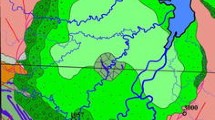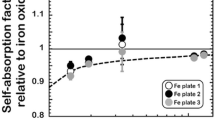Abstract
The elemental composition of the fragment of one of the biggest meteorites, which entered the Earth's atmosphere over Chelyabinsk, Russia was investigated by instrumental neutron activation analysis at the IBR-2 reactor. A total of 27 major and trace elements Si, Ti, Cr, Al, Fe, Mn, Mg, Ca, Na, K, V, Sc, Co, Ni, Zn, As, Se, Rb, Mo, Ag, Sb, Cs, Sm, Tm, Ir, Au, U was determined in the analyzed fragment. Obtained values were compared with the average composition of LL-chondrites and results reported by other scientific groups.

Similar content being viewed by others
References
Bezaeva NS, Badyukov DD, Nazarov MA et al (2014) Magnetic properties of the LL5 ordinary chondrite Chelyabinsk (fall of February 15, 2013). Meteorit Planet Sci 49:958–977. https://doi.org/10.1111/maps.12307
Galimov EM, Kolotov VP, Nazarov MA et al (2013) Analytical results for the material of the Chelyabinsk meteorite. Geochem Int 51:522–539. https://doi.org/10.1134/S0016702913070100
Koroteev VA, Berzin SV, Erokhin YV et al (2013) Composition and structure of the Chelyabinsk meteorite. Dokl Earth Sci 451:839–842. https://doi.org/10.1134/S1028334X13080023
Popova OP, Jenniskens P, Emel’yanenko V et al (2013) Chelyabinsk airburst, damage assessment, meteorite recovery, and characterization. Science 80(342):1069–1073. https://doi.org/10.1126/science.1242642
Badyukov DD, Dudorov AE (2013) Fragments of the Chelyabinsk meteorite shower: distribution of masses and sizes and constraints on the mass of the largest fragment. Geochem Int 51:583–586. https://doi.org/10.1134/S0016702913070070
Kaeter D, Ziemann MA, Böttger U et al (2018) The Chelyabinsk meteorite: new insights from a comprehensive electron microscopy and Raman spectroscopy study with evidence for graphite in olivine of ordinary chondrites. Meteorit Planet Sci 53:416–432. https://doi.org/10.1111/maps.13027
Morlok A, Bischoff A, Patzek M et al (2017) Chelyabinsk–a rock with many different (stony) faces: an infrared study. Icarus 284:431–442. https://doi.org/10.1016/j.icarus.2016.11.030
Righter K, Abell P, Agresti D et al (2015) Mineralogy, petrology, chronology, and exposure history of the Chelyabinsk meteorite and parent body. Meteorit Planet Sci 50:1790–1819. https://doi.org/10.1111/maps.12511
Ozawa S, Miyahara M, Ohtani E et al (2014) Jadeite in Chelyabinsk meteorite and the nature of an impact event on its parent body. Sci Rep 4:1–5. https://doi.org/10.1038/srep05033
Lutoev VP, Potapov SS, Isaenko SI, Lysyuk AYu, Yu S, Simakova MFS (2013) Mineral substance of the meteorite chelyabinsk: infrared absorption, raman and 57fe mossbauer spectroscopy. Becтник инcтитyтa гeoлoгии Кoми нayчнoгo цeнтpa Уpaльcкoгo oтдeлeния PAH
Berzin SV, Erokhin YV, Ivanov KS, Khiller VV (2016) Features of mineral and geochemical composition of Chelyabinsk meteorite. Извecтия Уpaльcкoгo гocyдapcтвeннoгo гopнoгo yнивepcитeтa
Antipin VS, Kuzmin MI, Mekhonoshin AS, Yazev SA (2019) The variations of chemical composition and features of the distribution of rare elements in chondrites of fragments of the Chelyabinsk meteorite. Lithosphere. https://doi.org/10.24930/1681-9004-2019-19-2-293-303
B. И. Cилaeв, B. H. Филиппoв, И. И. Гoлyбeвa, B. П. Лютoeв, C. C. Пoтaпoв, Ю. C. Cимaкoвa, B. A. Пeтpoвcкий AФX (2014) Meтeopит Чeлябинcк. Peзyльтaты минepaлoгo-гeoxимичecкиx иccлeдoвaний. In: Meтeopит Чeлябинcк — гoд нa Зeмлe. pp 443–473
Kichanov SE, Kozlenko DP, Kirillov AK et al (2019) A structural insight into the Chelyabinsk meteorite: neutron diffraction, tomography and Raman spectroscopy study. SN Appl Sci 1:1–9. https://doi.org/10.1007/s42452-019-1614-x
Stefanik M, Cesnek M, Sklenka L et al (2020) Neutron activation analysis of meteorites at the VR-1 training reactor. Radiat Phys Chem. https://doi.org/10.1016/j.radphyschem.2019.108675
Serafima S, Duliu OG, Manea MM et al (2019) Complex investigation of the five 19th century Russian-Lipovan icons. Microchem J 150:104126. https://doi.org/10.1016/j.microc.2019.104126
Zinicovscaia I, Sturza R, Duliu O et al (2020) Major and trace elements in moldavian orchard soil and fruits: assessment of anthropogenic contamination. Int J Environ Res Public Health 17:1–19. https://doi.org/10.3390/ijerph17197112
Abdusamadzoda D, Abdushukurov DA, Duliu OG, Zinicovscaia I (2020) Assessment of the toxic metals pollution of soil and sediment in zarafshon valley, Northwest Tajikistan (Part ii). Toxics 8:1–18. https://doi.org/10.3390/toxics8040113
Shirai N, Hidaka Y, Yamaguchi A et al (2015) Neutron activation analysis of iron meteorites. J Radioanal Nucl Chem 303:1375–1380. https://doi.org/10.1007/s10967-014-3654-4
Abedinzadeh Z, Moatar F, Farzad GH (1978) Non-destructive neutron activation analysis of the Naragh meteorite. J Radioanal Chem 43:229–232. https://doi.org/10.1007/BF02519460
Hatsukawa Y, Miyamoto Y, Hayakawa T et al (2008) Measuremets of presolar grain in meteorite using neutron activation analysis with multi-parameter coincidence method. J Radioanal Nucl Chem 279(1):213–216
Morgan JW, Rebagay TV, Showalter DL et al (1969) Allende meteorite: some major and trace element abundances by neutron activation analysis. Nature 224:789. https://doi.org/10.1038/224789b0
Zaytsev D, Borodin EN, Dudorov AE, Panfilov P (2021) The mechanical properties of Chelyabinsk LL5 chondrite under compression and tension. Earth, Moon Planets 125:1–11. https://doi.org/10.1007/s11038-021-09539-x
Galimov EM (2013) Chelyabinsk meteorite-an LL5 chondrite. Sol Syst Res 47:255–259. https://doi.org/10.1134/S0038094613040126
Zinicovscaia I, Pavlov SS, Frontasyeva MV et al (2018) Accumulation of silver nanoparticles in mice tissues studied by neutron activation analysis. J Radioanal Nucl Chem 318:985–989. https://doi.org/10.1007/s10967-018-6193-6
Nekhoroshkov PS, Bezuidenhout J, Frontasyeva MV et al (2021) Trace elements risk assessment for consumption of wild mussels along South Africa coastline. J Food Compos Anal 98:103825. https://doi.org/10.1016/j.jfca.2021.103825
Zinicovscaia I, Gundorina S, Vergel K et al (2020) Elemental analysis of Lamiaceae medicinal and aromatic plants growing in the Republic of Moldova using neutron activation analysis. Phytochem Lett 35:119–127. https://doi.org/10.1016/j.phytol.2019.10.009
Vinogradov AP (1965) The composition of meteorites. Pure Appl Chem 10:459–494. https://doi.org/10.1351/pac196510040459
Kaizer J, Kučera J, Kameník J et al (2017) Determination of elemental content in the Rumanová, Uhrovec, Veľké Borové, Košice and Chelyabinsk chondrites by instrumental neutron activation analysis. J Radioanal Nucl Chem 311:2085–2096. https://doi.org/10.1007/s10967-017-5168-3
Wasson JT, Kallemeyn GW, Wasson JT, Kallemeyn GW (1988) Compositions of chondrites. Philos Trans R Soc London Ser A, Math Phys Sci 325:535–544. https://doi.org/10.1098/rsta.1988.0066
Povinec PP, Laubenstein M, Jull AJT et al (2015) Cosmogenic radionuclides and mineralogical properties of the Chelyabinsk (LL5) meteorite: What do we learn about the meteoroid? Meteorit Planet Sci 50:273–286. https://doi.org/10.1111/maps.12419
Funding
This research did not receive any specific grant from funding agencies in the public, commercial, or not-for-profit sectors.
Author information
Authors and Affiliations
Contributions
All authors contributed to the study conception and design of the experiment and read and approved the final version of the manuscript.
Corresponding author
Ethics declarations
Conflict of interest
The authors declare that they have no conflicts of interest.
Additional information
Publisher's Note
Springer Nature remains neutral with regard to jurisdictional claims in published maps and institutional affiliations.
Rights and permissions
About this article
Cite this article
Kirillov, A., Grozdov, D., Zinicovscaia, I. et al. Elemental composition of the Chelyabinsk meteorite determined by neutron activation analysis. J Radioanal Nucl Chem 331, 249–253 (2022). https://doi.org/10.1007/s10967-021-08078-z
Received:
Accepted:
Published:
Issue Date:
DOI: https://doi.org/10.1007/s10967-021-08078-z




